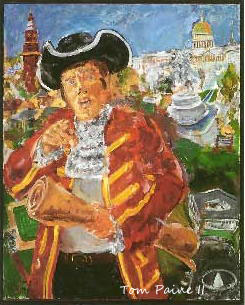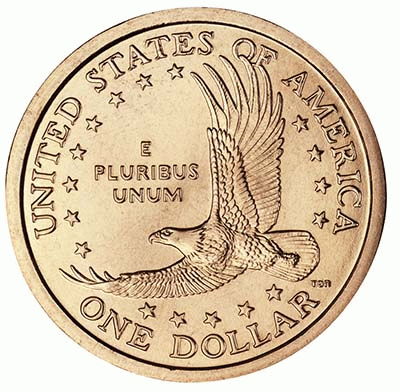One Dollar coin, back by public
Look after the dollar and the trillions will look after themselves.
NEW YORK, Cooper Union, May 12, 2013 -- As the most recent debt
ceiling deadline drew close, the extraordinary proposal to pay off public debt with
a fistful of trillion-dollar coins momentarily gained traction. Pundits pointed out that, to avoid default, the
President could unilaterally so order, based on the arguably controlling 14th
Amendment mandate that "[t]he validity of the public debt " shall not be
questioned." Obama was ultimately
obliged to respond. He did so by squelching
the idea conclusively enough to reinforce the popular perception of the trillion-dollar
coin as an absurd and academic gimmick. This
pamphlet construes the episode as an early teaching moment, on which to build.
The trillion-dollar coin proposal gave subtle notice that the
government does not issue the nation's paper
money; and it drew the nation one notch
closer to realizing how, by similarly issuing trillions of dollars in paper and
digital money, private banks garnish from the public amazing sums -- sums that
operate as a hidden flat tax on the nation as a whole, which under the
constitution should be used only for the general
welfare, and would be, if those sums were instead issued by the government, the same way that it mints coins. This article proposes to advance the public's
education by one more conceptual notch, re paper money. Fractional expansion of the currency through
digitized credit accounting is a concept not reached. This focus on cash avoids theories as to banks
earning the sums they garnish, by applying expertise in its distributions. Paper money issues wholly automatically, to meet
global demands for ready cash.
However, the notch of understanding I propose is not modest. It is the jolting realization that banks
routinely perform the trillion-dollar coin trick for themselves, by issuing the
nation's paper money as banknotes; so
that, in effect, simply deleting the smaller
words "Federal Reserve Note" from all new and replacement paper notes would rapidly,
dramatically and justifiably retire public debt. I have recorded a lyrical video noting how the
words "United States" would then stand proud, true and alone. Treasured
Notes, YouTube. Naturally, the
public presently takes at face value the Treasury's misleading mantra that "United
States Notes serve no function
that is not already
adequately served by Federal Reserve Notes," which appears three times on its
website. Given the grandiose "United
States" captions on both sides of every Federal Reserve note, to the bamboozled
public this fundamental falsehood seems as true and trite as a tautology.
For the purpose of public education as to the game-changing, debt-dissolving
advantages of true United States currency (coin/note/digital) over Federal
Reserve currency (note/digital), the trillion dollar coin has been somewhat
self-defeating. The immense value per
coin, while garnishing headlines, by the same token seems so frivolous that central
bankers (and their government minions and economic entourages) are even happy
to draw attention to it. Without
requiring any explanation, merely citing the trillion-dollar coin is enough to draw
ridicule upon those who rationally support the underpinning possibilities of truly
public money supplies.
But not all is lost. Through
the trillion-dollar coin, the public has implicitly been exposed to the
underpinning fact that there is something structurally different about minting coins,
versus printing money . The foreclosed trillion-dollar coin debate
can now be exploited to explain and explode an ongoing one-dollar "coin-swap" controversy,
transforming the public's vague awareness of some key distinction between coins
and notes into a concrete realization of the fundamental difference between
United States currency and Federal Reserve currency. This message is heavily underscored by underhand
anti-coin activism at the Federal Reserve.
Why do you think the
1979 Susan B. Anthony dollar was so similar to a quarter that its production soon
had to be halted? An ex-Mint chairman's grouse
re more recent "barriers" to distribution is at http://financialservices.house.gov/uploadedfiles/hhrg-112-ba19-wstate-pdiehl-20121129.pdf .
In complete contrast to their perfunctory ridiculing of the trillion-dollar
coin concept, the Federal Reserve and the Treasury are so afraid of what the public
might learn from the one-dollar coin that for 22 years they have painstakingly mentored
a series of 8 GAO reports that grossly understate the financial benefit that
would automatically accrue to the
government by replacing all one-dollar Federal
Reserve notes with one-dollar United
States coins. In the GAO reports -- or
rather, in regularly attached Treasury and Federal Reserve letters of comments
-- what began as a successful strategy of damning the dollar-coin by falsified faint
praise, has become falsified direct damning.
In 2012, citing the arbitrary exclusion of seigniorage from
CBO budget scores, the seventh GAO coin-swap report (GAO-12-307) contained a
section headlined: "Without Counting Seigniorage, Switching To A $1 Coin Would
Result In A Net Loss." The word "net" is
inappropriate, since it imputes full inclusion.
Next time, let the GAO add a section entitled: "Counting All Seigniorage
Shows A Net Public Debt Reduction In Excess Of $58 Billion." Make no mistake. The GAO's coin-swap reports represent a hot
battleground in a mostly undercover seigniorage war. Come to
the front! "O! Ye who love mankind,
stand forth!" (Paine, Common Sense.)
In 1989, the Federal Reserve gave the GAO a coin-swap costing
model implant that included a trivial concessionary fraction of real seigniorage
revenue. Ever since, the GAO has reproduced
that tiny slice of the seigniorage pie, which it presents as the whole pie. To the Federal Reserve and Treasury, this once
tolerated fleck of truth has grown into a grating and potentially fatal revelatory
mistake. It is now far easier for central
banking establishmentarians to blithely assert that all seigniorage should forthwith be disregarded in deference to a
CBO accounting convention, than to explain decades of brazen suppression of the
vastly larger dollar sums obviously at bar.
How could they possibly explain away a 22 year
series of 8 reports that forever fails to state the principal amounts by which
the public debt is directly reduced through seigniorage, even though it reports
interest relief due on such reductions?
The principle reductions necessarily come first, and of course dwarf the
actually reported consequent interest relief.
Explanation is especially difficult in light of government accounting
standards promulgated by the GAO itself, which explicitly require a clear statement
of both principal and interest gains and losses, in reporting net tax benefits.
And both explanation and excuse are
quite impossible in light of the interest relief understatement being no less
than a factor of six arithmetical error.
In the 1840s, persistent coin-banknote conflicts resulted in a durable
Independent Treasury Act under which the Treasury would not deal in banknotes,
owing to incorrigible serial lootings of the public fisc by banks. Today, Ye Olde Seigniorage War is in small
but significant part being fought over the puny but resilient one-dollar coin. The dollar coin is the private banking
monopoly's Achilles heel, for it faithfully and indelibly preserves the structurally
different accounting script under which true United States notes might again
issue. The distinct and advantageous option of true United States notes is obfuscation-proofed
by pragmatically defining Unites States notes as paper money issued per the
accounting procedures under which coins are now issued.
I have narrowly targeted this Achilles heel in a litigation now on
appeal in the Ninth Circuit, which seeks a finding of misrepresentation re the GAO's
purportedly objective coin-swap net benefit estimates. Johnson
v. United States Department of the Treasury, No. 12-16775. Links to the filings are under the Treasury
menu at commondada.com. Here is
paragraph 8 of the complaint, as drafted in January 2012 (since when there have
already been another two such GAO reports):
8. Financial Misrepresentations. (i) Coin-Swap
Question. A March, 2011 General
Accounting Office report (U.S. COINS:
Replacing the $1 Note with a $1 Coin Would Provide a Financial Benefit to the
Government, GAO-11-281) answered the following question for Hon. Richard
Shelby, ranking member, Committee on Banking, Housing and Urban Affairs, United
States Senate: What is the estimated net benefit, if any, to the government
of replacing the $1 note with a $1 coin?
(ii)
Game-Changing
Seigniorage. Answering this
question requires costing the seigniorage benefits that automatically readjust
when United States currency, coin or note, mixes with and/or replaces Federal
Reserve currency. Thus, answering this
question on the small scales of coinage implicitly answers it on every scale,
including complete conversion of the currency. These benefits are in fact so
high that they swamp the benefits that the GAO report instead labors to
compute, as follows. Had the face-value
seigniorage benefits been properly included in the GAO report, they would have
trumpeted the huge and prompt debt reducing advantages of United States
currency.
(iii)
Model Falsehoods. The 2011 GAO report trustingly adopts a
Federal Reserve model which impertinently presumes that the government must operate in debt, and which misrepresents that:
(a) when a new $1 coin is put in
circulation, the only government
benefit is the relief from interest on $1 of debt; and (b)
there is no government benefit when a $1 coin replaces a $1 note, because the
interest relief from $1 is offset by the loss of interest from $1 in Federal
Reserve profits returned to the government.
In fact: (a) when a new $1
coin is issued, the government's account is credited with $1; and (b)
when a $1 note is replaced by a new $1 coin, the government (when in debt) also
obtains relief from interest on 81.5 cents, since the Federal Reserve owns only
18.5% of the debt held by the public.
(Note: You can view every article as one long page if you sign up as an Advocate Member, or higher).






